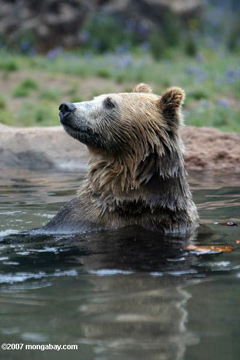Bears pressured by development in the Canadian Rockies
Bears pressured by development in the Canadian Rockies
WCS
October 30, 2007
REPORT SAYS BOOMING DEVELOPMENT IN CANADIAN ROCKIES THREATENS TO SQUEEZE BEARS AND OTHER WILDLIFE
The southern Canadian Rockies are still home to the most diverse assemblage of carnivores in North America, but a new report released today by the Wildlife Conservation Society Canada (WCSC) says booming development there could threaten them without careful planning and the implementation of conservation safeguards.
The report states that the southern Canadian Rocky Mountains —— between Banff National Park and Glacier National Park at the U.S. border —— are strategically important in maintaining broad ecological connectivity in the western mountains of North America. The predominant orientation of mountains and valleys there provides natural north-south movement routes for wide-ranging carnivores. However, this natural connectivity is vulnerable to fracture by the transportation and development corridor along the Crowsnest Highway (Hwy 3), which runs mostly east-west across southern Alberta and British Columbia.

|
The report says that expanding human developments and associated activities may fragment carnivore populations into smaller and more vulnerable units, leading to less genetic mixing of individuals between populations, and restricted options for ecological and geographic shifts in response to climate change. The report concludes that secure habitat areas and connecting linkages need to be established to facilitate movements by these wide-ranging carnivores.
The report focuses on six species of wide-ranging carnivores — grizzly bear, lynx, badger, bobcat, wolf, and wolverine — representing a broad variety of ecological conditions. The research team was led by Dr. Clayton Apps of Aspen Wildlife Research based in Calgary and Dr. John Weaver of WCS Canada, and also included Dr. Paul Paquet, Bryce Bateman, and Dr. Bruce McLellan.
The researchers first developed computer models to map the distribution of each selected species across the entire 30,000 square kilometer (11,500 square miles) southern Canadian Rockies. Then, they conducted field surveys that involved hair-snagging and DNA analyses to determine the occurrence of grizzly bears and lynx surrounding the Crowsnest Highway. With this scientific information, the researchers identified 15 core areas for security and 11 important linkages or connections for movement across and around the highway. The Flathead and Elk River basins appeared to be particularly important areas.
According to the report, scientific studies along other major highways in the region indicate that highways with high traffic volume strongly restrict carnivore movements and have the potential to fragment populations. Grizzly bears are particularly vulnerable to these effects, with reproductive females being especially susceptible. Trains running on railroads that parallel major highways have been a major source of mortality for bears. However, perhaps the greatest impact of highways and major roads is the cumulative human activity and associated development that they have facilitated over decades.
“There is a timely opportunity now to safeguard this diverse community of carnivores by managing human access, avoiding excessive mortality through appropriate hunting and trapping regulations, and maintaining options for wide-ranging wildlife to move across the bustling Crowsnest Highway where developments are expanding,” said Dr. Weaver.
“WCS Canada produced this report to help inform decision makers — whether they are government ministers, highway planners or community members — about what is at stake for these wide-ranging and vulnerable carnivores in a region of international importance,” said Dr. Justina Ray, executive director.













